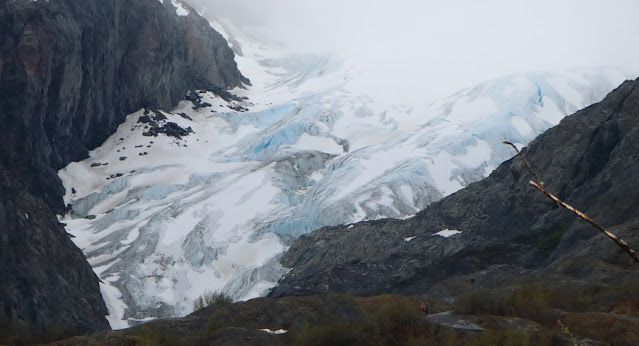ALASKA SEA LIFE
15-26 May 2021
Southwestern Alaska is a
wonderful mix of mountains and marine ecosystems—all tossed together in a
tectonic jumble. I spent a number of days living right on the north shore of
the Cook Inlet, an arm of the Gulf of Alaska, and I also took a day-long boat
trip from Seward, sailing south down Resurrection Bay and then around a
peninsula and into Aialik Bay and right up to the glacier at the head of that
rugged embayment, in Kenai Fjords National Park.
Cook Inlet is home to pods of
Beluga Whales, which one can glimpse in bush plane overflights and also when
patiently watching from the shore. I saw them on several occasions, just specks
of white appearing on the surface of the Inlet, as the creatures popped their
heads above the surface for air.
On the 26th of May, Alaska
birding expert Dr. David Sonneborn drove me down to Seward to take the six-hour
“National Park” boat trip offered by Kenai Fjords Tours. The early morning
drive from Anchorage to Seward took us through stunning scenery, first
following Turnagain Arm of Cook Inlet, and then down Seward Highway hemmed in
by wondrous snow-covered mountains—the Chugatch on one side, the Kenai on the
other.
Exit Glacier at Kenai Fjords National Park visitor center
Before the boat ride, David drove
me to the Kenai Fjords National Park visitor center, which is situated right
below the terminus of the Exit Glacier, which was my first close-up experience
with such a massive accumulation of ice. The pale bluish color of the ice is
quite fetching.
We brought lots of cold-weather
gear for the boat trip, but not enough. The combination of the speed of the
boat and the outdoor temperature and humidity made it difficult to weather the
outdoor conditions on the boat from long periods of time. We had been hot the
day before in Anchorage. On this day we were very cold. Major wind-chill!
The Seward harbor featured
Black-legged Kittiwakes, looking a lot like Mew Gulls, which is the common
species in downtown Anchorage. There
were also some of the larger Glaucous-winged Gulls (a population that has
hybridized with Herring Gulls).
Steller’s Sea Lions populated
some of the small rocky islets along the route of our boat ride. These are
always a pleasure to watch—they are so variable, from the powerful oversized
males to the tiny babies...
Hump-backed Whales were out and
about. I have spent a lot of time with this species off of Provincetown.
The featured marine mammal was
the Orca (Killer Whale) a lifer for me. Pods of Orcas loafed about one
particular bay, and I shot a lot of images of them, trying to capture the
creatures themselves, not just their fins. That is a tough assignment...
The featured seabirds of the
cruise were the Alcidae (auks and allies), of which I encountered six species
on the trip. The prettiest was the Tufted Puffin.
The Horned Puffin was also quite
pleasing to the eye (and a lifer too!).
The Rhinoceros Auklet was in
breeding plumage, and pretty nifty, but not at all confiding. A lot of the
alcids would be sitting on the water and then launch off away from the boat as
it approached.
We encounter Marbled Murrelets in
breeding condition right in Seward harbor, and also in other spots. This
species is fairly common in these parts. Lots of rainforest to nest in.
Marbled Murrelets (two pictures above)
We encountered a few pairs of Pigeon
Guillemots, which are handsome, and which closely resemble their East Coast
cousins—the Black Guillemot.
Perhaps Kittlitz’s Murrelet was
the most exciting bird of the trip. It was a lifer for me, and was one of those
species I had not planned to see here...
Another surprise to me was
encountering two species of storm-petrels (Fork-tailed and Leach’s) the first whitish, the second blackish with a
white rump. Both were foraging low over the icy water up near the calving
glacier at the head of Aialik Bay.
Leach's Storm-Petrel (uppermost image), and Fork-tailed Storm-Petrel (just above)
I did not see phalaropes on this
boat ride, but I had them breeding in the North Bog at Beluga, and I include it
here, because it spends most of its
life far out at sea.
Sea Otters were about and easy to
see, flat on their backs bobbing around on the water’s surface. I encountered
one large group of perhaps 10 individuals.
Sea Otters (2 images above)
Here is the Aialik Glacier that
we spent time with. The boat parked and waited for the glacier to peel off some
of its ice. The sound of the ice dropping into the water was like thunder—it is
very impressive. Geological in its massive force...





























What a beautiful collection and awesome moments you have...
ReplyDeleteWe are experts in pet relocation and we have moved more than 5000 pets worldwide. International Pet Transport | Domestic Pet Transport | Pet Moving Services in India